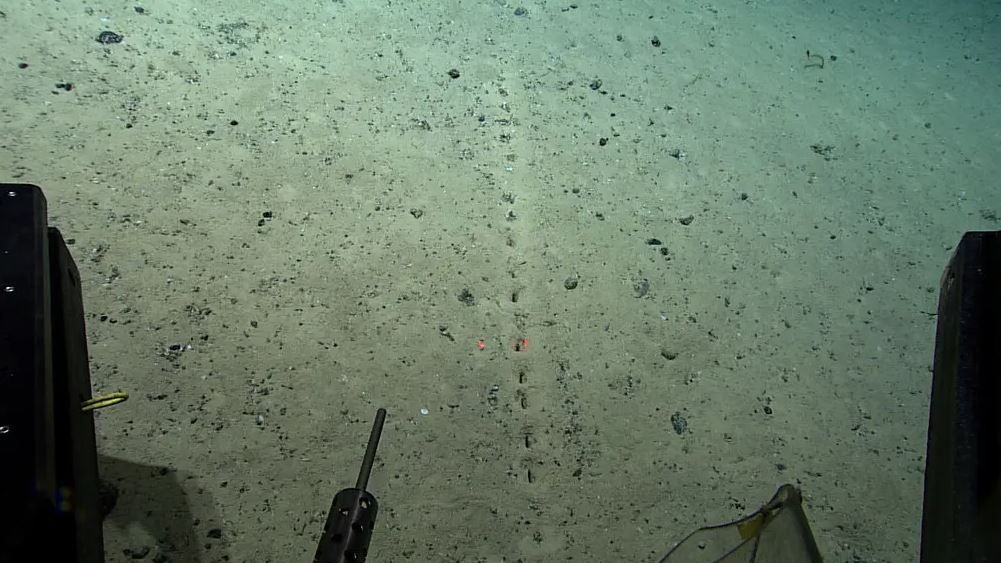Using a remotely controlled vehicle, marine researchers discovered a pattern of holes in the sand at the bottom of the Atlantic Ocean’s volcanic ridge.
There were at least 12 holes resembling a 1.6 mile-long trail of lines on the ocean bottom during the July 23 dive north of the Azores, near Portugal’s mainland.
The Azores Plateau, an undersea region where three tectonic plates intersect, had four further sightings on Thursday, nearly a week later. Nearly three hundred miles distant from the expedition’s original finding location, these holes reached a depth of nearly one mile.
Researchers don’t know what the holes are, but they have seen similar patterns previously and consider them “lebensspuren,” German for “life traces,” which refers to imprints in sediment that might be made by living beings.
The scientists are asking themselves and the public on social media: What is causing these markings, which have holes spaced at least four inches apart and lines that reach more than six feet, to appear on the ocean floor?
Scientists are baffled as to where the holes came from, according to a tweet from the NOAA Ocean Exploration project. There are small heaps of silt surrounding the holes that indicate that they were dug by something other than humans.
Scientists observed similar holes about two decades earlier, roughly 27 miles distant from the current expedition’s first finding, Emily Crum, a NOAA spokesman, said.
A deep-sea researcher who participated on the last voyage and is now working in this one says that time hasn’t yielded any clear answers.
This is a significant event, but we don’t know what it is yet, according to Dr. Vecchione.
The Mid-Atlantic Ridge, a vast deep-ocean series of mountains that runs more than 10,000 miles under the Atlantic Ocean, is one of the topics scientists on an ambitious ocean expedition are examining as they investigate the holes.
Voyage to the Ridge 2022, a series of three NOAA missions that started in May and will end in September, is a search for solutions that will take scientists from Rhode Island through the Azores and back to Puerto Rico.
Geological processes that provide life-sustaining heat may be interrupted, and explorers are interested in learning more about what happens when they do so.
On the Okeanos Explorer, scientists are keeping a careful eye on populations of deep-sea coral and sponges, which Derek Sowers, an expedition organiser, calls “some of the most important marine ecosystems on Earth.”.
“The unique chemicals created by all of these life-forms,” stated Dr. Sowers, were “essential” to comprehending the planet’s biodiversity and the “novel compounds.”
Deep-sea life, unlike most of Earth’s inhabitants, gets its energy not from the sun, but from magma-heated saltwater.
According to Dr. Sowers, “this has increased our knowledge of the circumstances under which life on other worlds may exist.”.
Hundreds of comments poured in as the agency went to social media to engage the public, some of which descended into guesswork. Are the holes in the ground man-made? Is it possible that these are a message from aliens? Submarine tracks may be seen in the sand. A “deep-sea species that bury themselves beneath the sand” may have “breathing holes.”
Dr. Vecchione didn’t think that final theory was out of the question. Mr. Vecchione and his co-author Odd Aksel Bergstad, a former researcher at the Institute of Marine Research in Norway, suggested two primary possibilities in a report on the holes observed in 2004. A marine animal could either walk or swim above the silt and poke holes down, or it could burrow below and poke holes up.
According to Dr. Vecchione, it seemed as though the holes appeared to have been forced out from under the surface on Thursday.
Dr. Sowers said the remote-controlled vehicle’s suctioning equipment gathered soil samples from the holes in order to determine whether there was an organism present.
Although he was thrilled to see the ocean bottom holes again, Dr. Vecchione expressed his disappointment that scientists were still unable to provide an explanation.
Is there an unsolved mystery out there? “It confirms the concept,” he remarked. That is, we haven’t uncovered the answer yet.
NOAA said there is one more dive to be done in the second trip in the series, which will be aired live. On August 7, the third expedition will commence.
